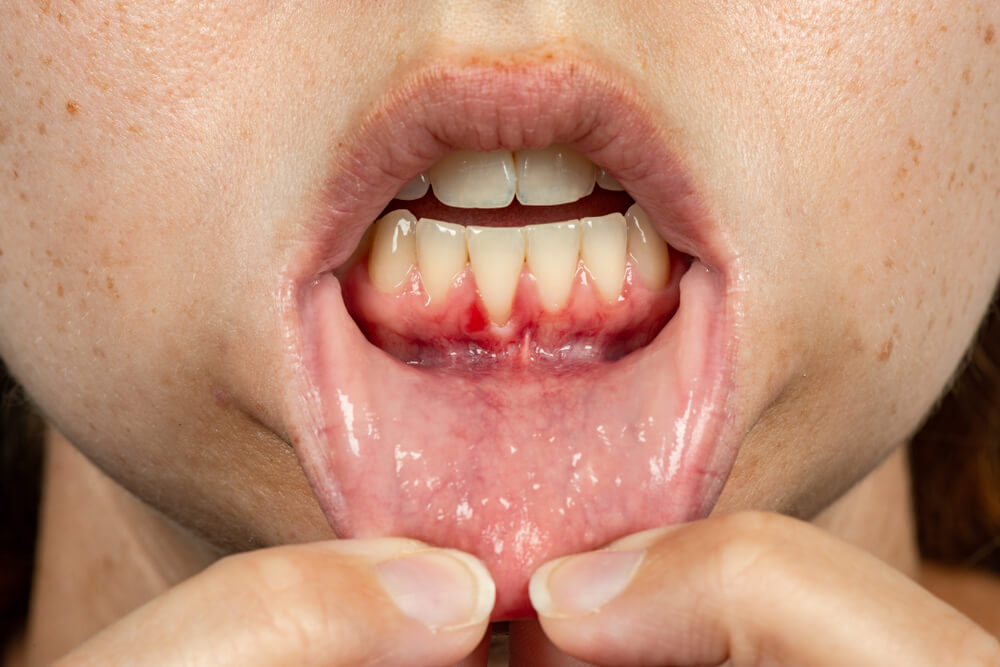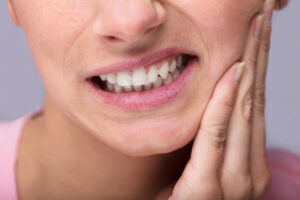Receding Gums | Your Complete Guide to Gum Recession

Receding gums occur when the gum tissue surrounding the teeth wears away or pulls back, exposing more of the tooth or the tooth’s root. This condition can lead to sensitivity, increased risk of cavities on the tooth root, and aesthetic concerns.
Key Takeaways
- Receding gums are when the gum tissue around your teeth wears away.
- This can expose the roots of your teeth, which can lead to pain, sensitivity, and tooth loss.
- There are many causes of receding gums, including poor oral hygiene, smoking, and genetics.
- Treatments for receding gums include gum grafting and scaling and root planing.
- Early detection is important to prevent tooth loss.
Table of Contents
What causes receding gums
Receding gums can be caused by several factors, often involving a combination of lifestyle habits and genetic predisposition. Common causes include:
- Gum disease (periodontal disease): This is the most common cause, where bacterial infections destroy gum tissue and the bone that holds your teeth in place.
- Aggressive tooth brushing: Brushing your teeth too hard or using a hard-bristled toothbrush can wear away enamel and cause the gums to recede.
- Poor dental hygiene: Insufficient brushing, flossing, and rinsing with antibacterial mouthwash makes it easy for plaque to turn into tartar — a hard substance that builds on and between your teeth and can lead to gum recession.
- Tobacco products: Smokers and those who use tobacco products are more likely to have sticky plaque on their teeth that is difficult to remove, which can lead to gum recession.
- Hormonal changes: Changes in hormone levels, particularly in women during puberty, pregnancy, and menopause, can make gums more sensitive and more vulnerable to receding.
- Grinding and clenching your teeth: These habits can put too much force on the teeth, causing gums to recede.
- Misaligned teeth or malocclusion: Crooked teeth or a misaligned bite can place too much pressure on the gums and bones, leading to recession.
- Genetics: Some people are more susceptible to gum disease, regardless of how well they care for their teeth and gums.
- Trauma to gum tissue: Injury to gum tissue, such as from a sports accident or brushing too hard, can lead to recession.
- Piercings: Lip or tongue piercings can rub the gums and irritate them to the point that gum tissue is worn away.
Who does gum recession affect?
Gum recession can affect people of all ages, but it’s more common in adults over the age of 65. This wider prevalence in older adults is often due to the cumulative effects of risk factors over time, such as poor oral hygiene habits, tobacco use, or untreated gum disease.
Younger adults and even teenagers are not immune, especially those with genetic predispositions to gum disease, those who practice aggressive tooth brushing, or those who have orthodontic issues that put additional stress on gums.
How common is gum recession?
Gum recession is quite common and affects over 88% of people who are 65 and over.
Because gum recession can progress slowly and without pain in its early stages, many individuals may not realize they are affected until it becomes more pronounced. Regular dental check-ups are crucial for early detection and management.
Receding Gums Symptoms
Symptoms of receding gums can vary from mild to severe and often develop gradually. Here are some of the key symptoms to look out for:
- Sensitive teeth: As gums recede, the roots of the teeth become exposed, leading to increased sensitivity, especially to hot and cold temperatures.
- Longer-looking teeth: Receding gums make teeth look longer than normal, which is why gum recession is sometimes referred to as “long in the tooth.”
- Exposed tooth roots: One of the more visible signs, the root of the tooth becomes exposed as the gum line recedes.
- Loose teeth: In advanced cases of gum recession, teeth may become loose due to the loss of gum tissue and the supporting bone structure.
- Bleeding after brushing or flossing: This can be a sign of gum recession and gum disease. Healthy gums should not bleed from routine cleaning. As soon as you start having gum recession, try to use a specially formulated toothpaste. Here is the best toothpaste for receding gums.
- Red, swollen gums: While this can also be a symptom of gum disease, it can accompany gum recession as the gums become more sensitive and inflamed.
- Pain or discomfort at the gum line: You may notice discomfort or pain along the gum line where the gums have receded.
- Changes in the way teeth fit together: Changes in your bite or the way your teeth fit together can indicate gum recession and bone loss.
- Visible gaps between teeth: As the gums recede, spaces between the teeth may become more pronounced due to the loss of supporting gum tissue.
What Type of Surgery Is Used to Treat Receding Gums?
The treatment for receding gums often involves surgical procedures, especially in cases where non-surgical methods such as deep cleaning or medication cannot address the issue effectively.
The types of surgery used to treat receding gums include:
Gum Graft Surgery
This is the most common surgical treatment for gum recession. It involves taking tissue from another part of your mouth (such as the palate) or using a donor material and grafting it onto the areas where the gums have receded.
This procedure helps to cover exposed roots, reduce sensitivity, and improve the appearance of your smile.
Regenerative Procedures
When the bone supporting your teeth has been destroyed due to gum disease, we usually recommend a regenerative procedure.
This involves folding back the gum tissue, removing the bacteria, and then using regenerative materials like membranes, bone grafts, or tissue-stimulating proteins to encourage your body’s natural ability to regenerate bone and tissue in the area.
Pocket Depth Reduction
In cases where the spaces between your teeth and gums (pockets) are too deep to clean effectively, this procedure might be used. The gum tissue is folded back, bacteria are removed, and the tissue is then secured in place over the tooth root, reducing the depth of the pocket.
I’ve had patients looking for ways to shrink gum pockets at home, but always consult with a dentist for such procedures. In most cases, you’ll do more harm than good.
Pinhole Surgical Technique (PST)
This is a minimally invasive option for treating gum recession. Instead of grafting, a small hole is made in the gum tissue, through which special tools are used to gently loosen the gum tissue and slide it over the areas of the teeth with receding gums.
The choice of procedure depends on the severity of the gum recession, the health of the patient, and specific needs or preferences. A consultation with a periodontist or a dental specialist is necessary to determine the most appropriate treatment option.
FAQ on Receding Gums
What causes receding gums?
Gum recession is often caused by periodontal disease, aggressive brushing, poor oral hygiene, genetic predisposition, tobacco use, and hormonal changes. Grinding or clenching your teeth can also contribute.
Can receding gums grow back?
Gum tissue does not regenerate like other tissue types, so receded gums cannot grow back. However, treatments like gum grafts can cover exposed roots and reduce further recession.
How can I prevent my gums from receding?
Prevent receding gums by maintaining good oral hygiene, using a soft-bristled toothbrush, avoiding aggressive brushing, and getting regular dental check-ups to detect early signs of gum disease.
What are the symptoms of receding gums?
Symptoms include increased tooth sensitivity, visibly longer teeth, and exposed tooth roots. You might also notice a notch near the gum line.
What treatments are available for receding gums?
Treatments range from non-surgical options like scaling and root planing to surgical interventions such as gum grafts and the pinhole surgical technique, depending on severity.
Is gum grafting painful?
While the thought of gum grafting might seem daunting, it’s generally well-tolerated with local anesthesia. Post-operative discomfort is usually manageable with over-the-counter or prescribed pain relief.
Can receding gums cause tooth loss?
Yes, if left untreated, receding gums can lead to tooth loss. Recession often exposes tooth roots, making them more susceptible to decay and periodontal disease.
How much does it cost to treat receding gums?
The typical cost for gum graft surgery varies between $600 and $1,200 for each tooth. Should gum contouring be added to enhance the aesthetic appeal of the gums, this procedure could increase the overall cost by several hundred dollars.
Are there any natural remedies for receding gums?
While maintaining good oral hygiene is paramount, some natural remedies like oil pulling, green tea, and vitamin C can support gum health. Don’t forget, they’re not substitutes for professional treatment.
How does smoking affect receding gums?
Smoking is a major risk factor for periodontal disease, which can lead to gum recession. It impairs blood flow to the gums, hindering healing and making smokers more prone to gum disease.
Fact Checked
Our dedicated team rigorously evaluates every article and guide to ensure the information is factual, up-to-date, and free of bias.
Updated Regularly
We update our articles and reviews regularly to ensure you have access to the latest data in the dental industry.
The content on Dental3DU’s blog is intended for educational purposes only. This information should not be relied upon as professional medical counsel. Be sure to always consult with your dentist about the dangers and benefits of any medication, treatment or procedure.







